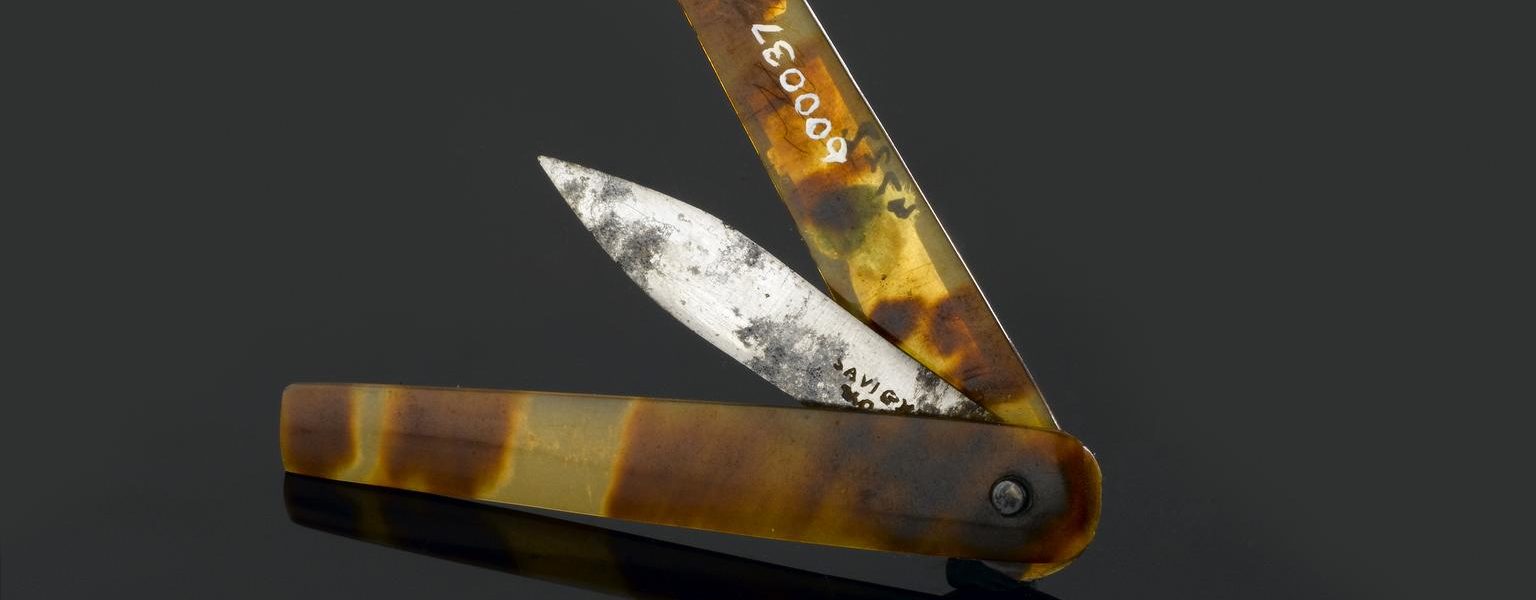Just over forty years ago, following an extensive global vaccination campaign, the world was declared free of smallpox. It remains the one infectious disease in humans that has been eradicated by such direct intervention.
But for as long as vaccines have existed, so too have expressions of doubt, concern, and suspicion about their use.
Vaccine hesitancy refers to ‘delay in acceptance or refusal of vaccination despite availability of vaccination.’
Such vaccine hesitancy has arisen for varied and complex social, political, and cultural reasons, ranging from misinformation or lack of credible information, to religious beliefs or simply wanting reassurance that a vaccine is safe.
The first vaccination against smallpox was carried out by the English country doctor Edward Jenner in 1796.
Smallpox was a highly infectious disease which caused rashes, pustules and often left people with deeply pock-marked skin. The disease also killed in large numbers and had an especially high fatality rate amongst young children.

Jenner had previously been variolating people, a method first recorded in China approximately a thousand years ago, which involved the deliberate infection of a person with a disease in the hope that a mild, but protective, infection would result.
In the local Gloucestershire countryside, Jenner became aware of a similar practice amongst local farming communities.
Milkmaids, who were renowned for their clear complexions, were often immune to smallpox and its scarring pock marks because they were exposed to a milder disease of cattle disease known as cowpox.
Jenner decided to test the effectiveness of this technique and in 1796 carried out his first successful vaccination.
He took pus from a cowpox pustule on the hand of milkmaid Sarah Nelmes and inserted it into a cut made in the arm of a young boy named James Phipps. This became known as the ‘arm-to-arm’ method as it involved the direct transferral of infected matter straight from one person’s arm to another.
Six weeks later, Jenner inoculated young James with smallpox matter and the boy showed no signs of the disease.
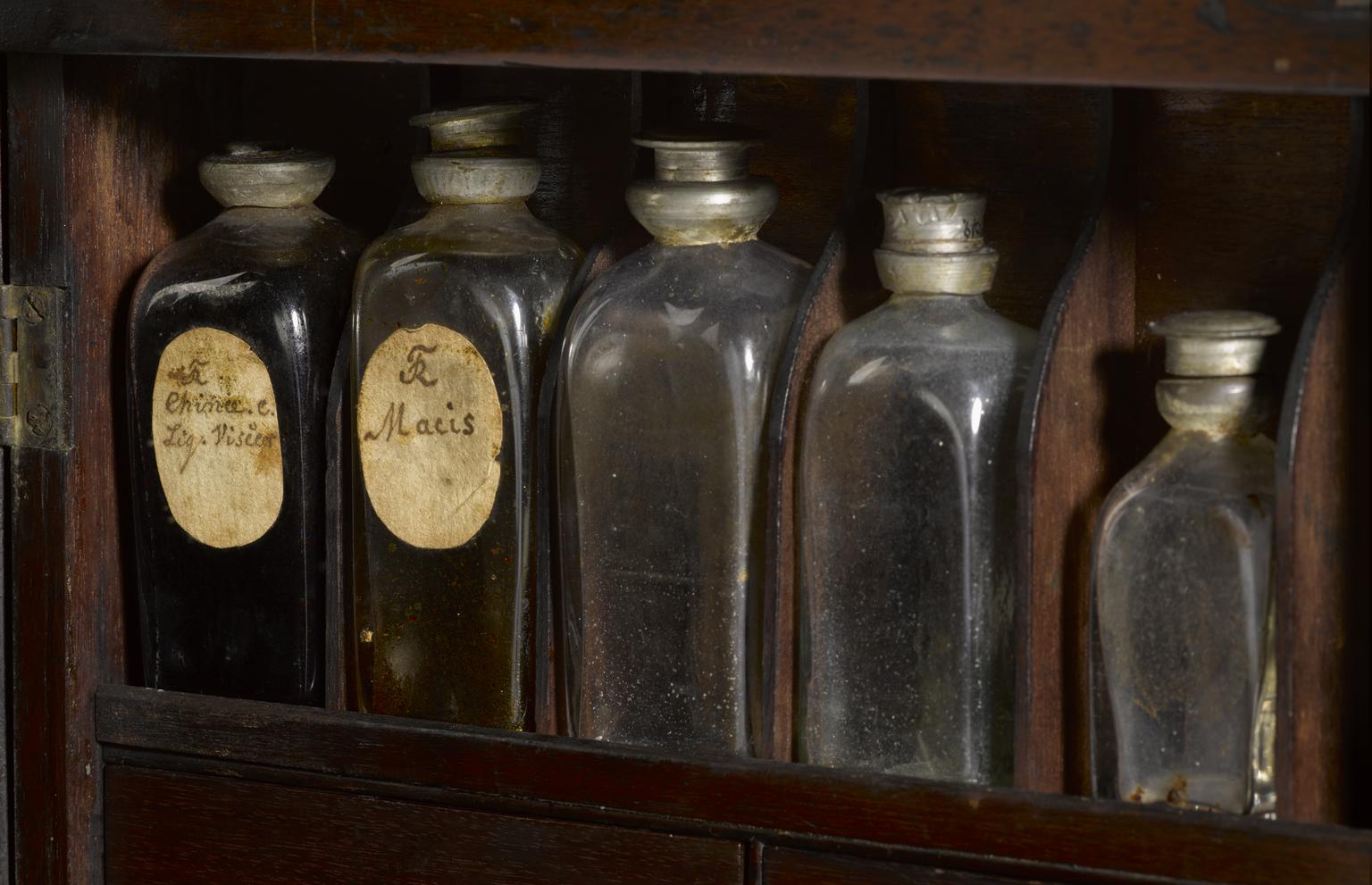
Jenner called the procedure ‘vaccination’ after the Latin word for cow (vacca) and published his findings to the scientific community.
Though his apparent discovery gained some interest, it was also met with criticism and even ridicule.
As with variolation, many early critics thought vaccination was unclean or immoral, especially because it involved transferring ‘foreign’ fluids into their bodies.
Whilst there was some support from members of the church, there was much religious opposition. Some Christian groups viewed scarring the skin and the introduction of foreign particles as a violation of the sacred body made in God’s image.
Satirical printmaker and caricaturist James Gillray created this cartoon in 1802, drawing on public concerns around vaccination. The scene depicts a crowd of vaccinated people thrown into disarray as they seemingly morph into cows with cattle leaping from their skin.
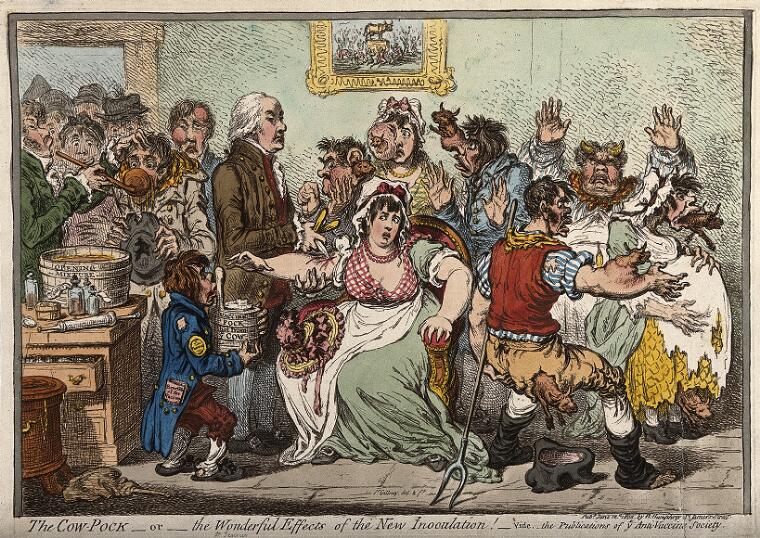
Resistance also came from some variolators who saw the loss of their lucrative business. Dr William Rowley, a prolific variolator, published a pamphlet in the hopes of damaging the vaccination cause.
His pamphlet entitled Cow-Pox Inoculation No Security Against Small-Pox Infection drew on the fears Gilray had mockingly portrayed in his cartoon, showing illustrations of an ‘Ox-Faced Boy’ and ‘Mange Girl’.
Pamphlets such as this depicting ‘vaccine disaster’ are an early example of the spreading of misinformation.
Historically, vaccination was much more painful than it is today, with at least four cuts made in the flesh of a person’s arm using a sharp blade or lancet. Vaccine matter would then be smeared into the cuts. The associated pain caused hesitation amongst some, though the promise of protection from deadly disease outweighed these fears for others.
Vaccination methods were also much less safe without today’s strict laboratory testing, trialling, and monitoring. Many had legitimate fears that the arm-to-arm method could spread other human illnesses, whilst others even feared it could spread mental illness.

In 1853, 30 years after Jenner’s death, smallpox vaccination was made compulsory under the 1853 Compulsory Vaccination Act with heavy penalties for those who didn’t comply.
This act, which was seen by many to take away personal choice and bodily autonomy, spurred a rise in the Victorian anti-vaccination movement. As a result, tens of thousands of people took to the streets to protest.
Anti-vaccinationists of the time were not only middle-class reformers but were also from the politically active working class.
Whilst the 1853 Act only applied to children, it provoked fears of smallpox outbreaks amongst employers. As a result, some demanded their employees be vaccinated or otherwise risk being fired.
This new law also caused anxieties around social status as well as ‘moral integrity’, with many opposing public vaccinations as it forced those who considered themselves to be of respectable working class into direct physical contact with paupers: ‘For the blood of those with questionable morals and debatable health, anti-vaccinationists maintained, could pollute that of their own respectable and ‘pure’ infants.‘
Whilst many took to the streets in protest, others rallied opposition in the form of anti-vaccination groups.
The leaflet featured below, published by the National Anti-Vaccination League in the 1880s, informs the reader that pock-marked faces were a “curious illusion” which were disappearing from society before vaccination was introduced – an attempt to debunk the success of vaccination.
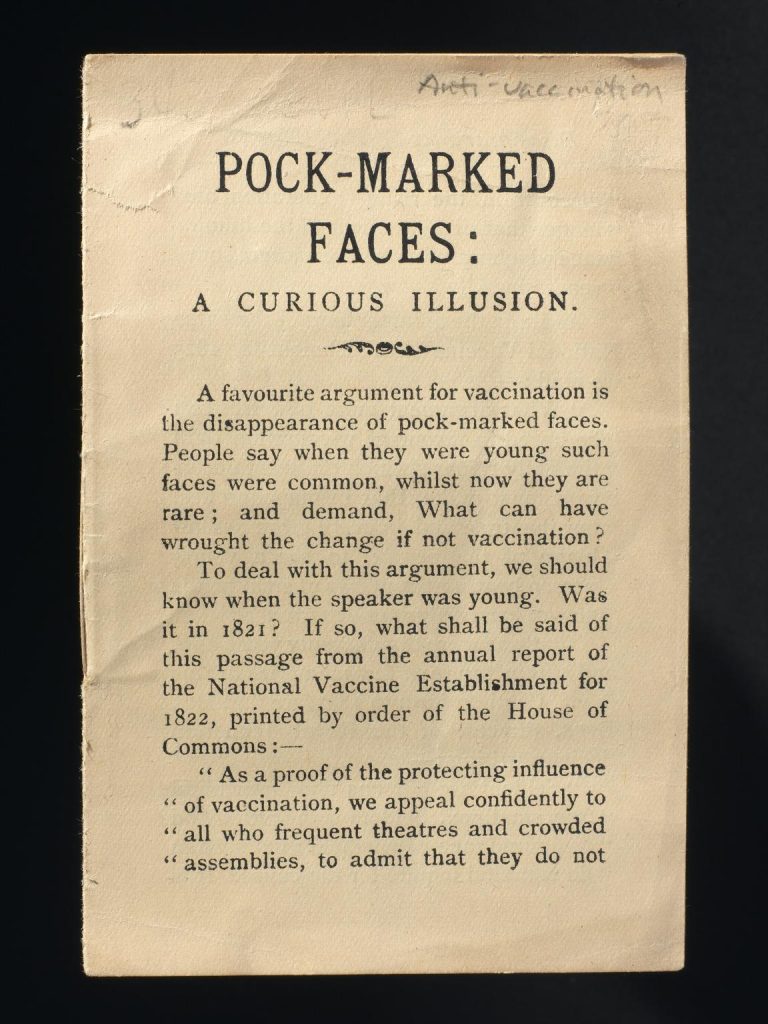
Campaigns against smallpox vaccination continued for years.
In 1923, in response to a smallpox epidemic in Gloucester and the surrounding areas, the following poster appeared as an article in The Times newspaper.
The medical correspondent for The Times referred to the anti-vaccination campaigns a month earlier, writing that the outbreak ‘need never have occurred if the population availed itself of vaccination. Few more lamentable demonstrations of the evil effects of a stupid and mischievous propaganda have ever been afforded.’
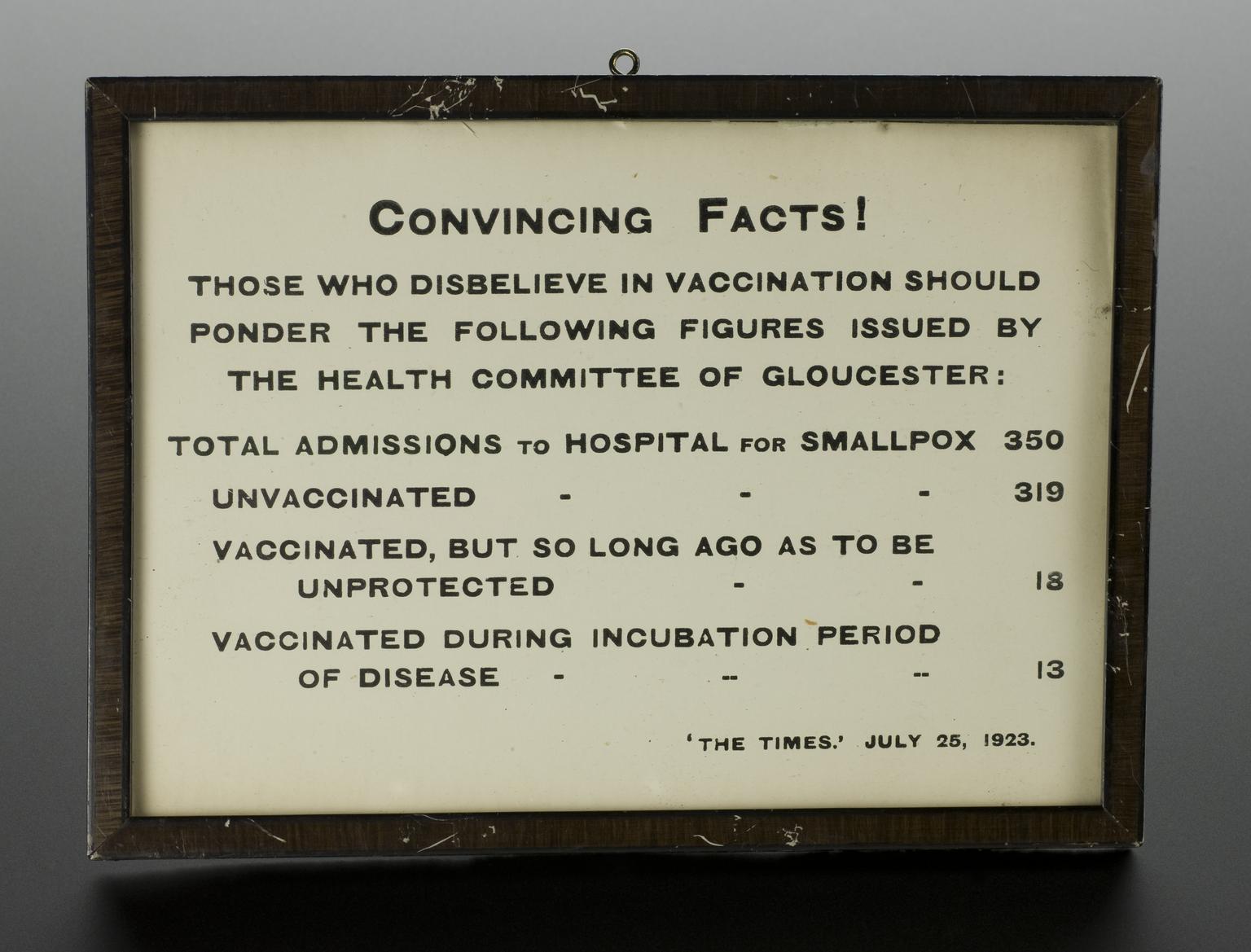
History tells us that vaccine hesitancy occurs for complex and wide-ranging factors. Though doubt, distrust and scepticism are certainly not resigned to the past.
The World Heath Organisation identified vaccine hesitancy as one of the ten biggest threats to global health in 2019.
The introduction and roll out of the COVID-19 vaccine in the UK has focussed attention once again on vaccine hesitancy, and how best to build public trust .
On 24 February 2021, the Science Museum hosted a discussion on vaccine hesitancy, with experts including US physician Dr Anthony Fauci, Vaccine Deployment Minister Nadhim Zahawi MP and Director of the Vaccine Confidence Project Professor Heidi Larson. You can watch it here.
Discover more about the history of smallpox and vaccination in this online story or by visiting Medicine: The Wellcome Galleries once the museum reopens.
You can also explore more about the science behind COVID-19 in our blog series.
